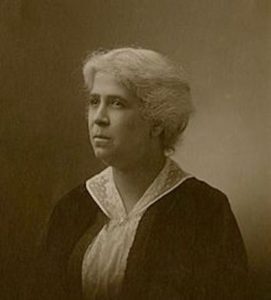
Mary Evans Wilson
*Mary Evans Wilson's birth is celebrated on this date in 1866. She was a Black teacher, journalist, and civil rights advocate.
Mary Evans came from a family of activists. In 1858, her father was one of a group of men arrested for the Oberlin–Wellington Rescue. Her uncle, Lewis Sheridan Leary, was killed in John Brown's raid on Harpers Ferry, West Virginia, and her cousin, John Anthony Copeland, Jr., was hanged with Brown. Years later, her mother delivered an address at Harpers Ferry at the second annual meeting of the Niagara Movement. Evans' sister, Anna Evans Murray, was a teacher, civic leader, and early proponent of free kindergarten classes for black children. Anna's husband, Daniel Murray, was a Library of Congress employee whose duties included obtaining copies of African American-authored books for the "Exhibit of Negro Authorship" at the Paris Exposition of 1900.
Evans moved to Washington, D.C., where she taught in public schools for ten years. She also wrote the Woman's Era newspaper's health and beauty column. On June 27, 1894, she and Butler R. Wilson, a Boston civil rights attorney, were married. The couple moved to 13 Rutland Square in Boston's South End, where they raised six children. In May 1899, Wilson was the keynote speaker at a women's anti-lynching demonstration in Boston's Chickering Hall. In her speech, she criticized President William McKinley for failing to address the problem of lynching and called for federal government intervention. Other speakers that day included Julia Ward Howe, Mary C. Leavitt, Alice Freeman Palmer, and Florida Ruffin Ridley.
Wilson and her husband were among the organizers of the Boston branch of the National Association for the Advancement of Colored People (NAACP). She volunteered as a traveling organizer, recruiting thousands of new members in New York, Ohio, and Pennsylvania. In 1916, Murray led an investigation into discrimination at the New England Sanitarium and a campaign to persuade Boston's department stores to hire black salespeople. She also worked to combat discrimination in the Boston school system. During World War I, she organized a knitting circle of 350 women and girls to provide gloves and scarves for Boston's Black soldiers.
The knitting club became the Women's Service Club in 1919, a charitable organization still operating at its original headquarters at 464 Massachusetts Avenue in the South End. It is one of Boston's oldest organizations for women of color. She also served on the advisory board of the Boston Trade School. Mary Evans Wilson died at her South End home on March 28, 1928. She is buried next to her husband in the Forest Hills Cemetery. She is remembered in connection with the Women's Service Club on the Boston Women's Heritage Trail.
to be a Journalist or Reporter
To Become a Media Producer or Director